The Samsung Galaxy S7 and S7 edge Review: Part 2
by Joshua Ho on July 5, 2016 8:00 AM ESTCamera Architecture and UX
In general, camera has become probably the single biggest point of differentiation between smartphones at this point. As smartphones are often the only camera that most people carry on a day to day basis, the rear camera on a smartphone really cannot be a disappointment relative to the competition. While we can talk about how much a front-facing camera matters in terms of quality, it’s pretty safe to say that for photos and videos that are worth saving will be taken with the rear-facing camera.
While post-processing and a number of other factors are going to have a huge impact on the overall camera experience, the foundation that makes it possible to deliver a great camera is always going to start at the hardware.
| Samsung Galaxy S Cameras | ||||
| Galaxy S6 Galaxy Note5 |
Galaxy S7 | |||
| Front Camera | 5.0MP | 5.0MP | ||
| Front Camera - Sensor | Samsung S5K4E6 (1.34 µm, 1/4.1") |
Samsung S5K4E6 (1.34 µm, 1/4.1") |
||
| Front Camera - Focal Length | 2.2mm (22mm eff) | 2.1mm (21mm eff) | ||
| Front Camera - Max Aperture | F/1.9 | F/1.7 | ||
| Rear Camera | 16MP | 12MP | ||
| Rear Camera - Sensor | Sony IMX240 Samsung S5K2P2 (1.12 µm, 1/2.6") |
Sony IMX260 Samsung S5K2L1 (1.4 µm, 1/2.6") |
||
| Rear Camera - Focal Length | 4.3mm (28mm eff) | 4.2mm (26mm eff) | ||
| Rear Camera - Max Aperture | F/1.9 | F/1.7 | ||
In the case of the Galaxy S7, Samsung has done something that I thought they’d never do, which is move backwards in resolution in order to improve pixel sensitivity. In the case of the Galaxy S7, Samsung has moved from the Sony IMX240/Samsung S5K2P2 to the Sony IMX260/Samsung S5K2L1 sensor, with a 1.4 micron pixel size relative to a 1.12 micron pixel pitch in the previous generation. This means that there’s a 56% increase in sensitivity per pixel. Assuming the same process technology, this does improve low light performance significantly. While to some extent it’s true that improved CIS (CMOS image sensor) technology can alleviate the downsides of smaller pixels, on the same technology you have to reduce your fill factor/active sensor area. The other problem is that while read noise on the sensor does reduce per pixel as you reduce pixel size, the overall sensor read noise trends upwards. This means that the region in which the CIS noise is primarily limited by shot noise is going to be smaller as you reduce pixel size. Shot noise is an unavoidable reality of existence, to the extent that even our eyes can see this “visual snow” if ambient light is sufficiently dim.
However, in the case of the Galaxy S7 I suspect that there’s more to the story, because the dual pixel AF system means that for each 1.4 micron pixel each pixel needs two photodetectors. In order to make phase detection work, there has to be sufficient spatial separation to make this system work properly, so some of the benefit of these larger pixels will inevitably be eaten up in order to enable PDAF that works in basically all lighting conditions.
The other notable change here is that the Galaxy S7 uses an even wider f/1.7 aperture. Unfortunately, in Samsung's efforts to try and make the module thinner they've made the focal length slightly shorter than before which results in an effective focal length of 26mm. This and the wider aperture could lead to compromises as light is entering the optics at a more extreme angle than before.
With these basics covered, we can move on to a discussion of the user experience. While in the past it was easy enough to just take some still shots on a tripod, a holistic view of camera quality really needs to take into account far more than just the end result. A poorly designed camera application with low resolution, low frame rate preview, improper preview aspect ratio, poor control layout, and other issues can easily make it difficult, if not impossible to get the photo that you want. These issues are thankfully getting less common, but these problems can make it almost impossible to recommend a phone for its camera, no matter how good the results are.
In the case of the Galaxy S7, the camera application is a nice upgrade over the Galaxy S6 at launch, but for the most part nothing is really different this go around. I’m not going to spend too much time here, but the short story is that I don’t think that Samsung is doing anything wrong here, and things are pretty much as good as they’re going to get.
While leaving it at that would be enough, I want to recognize some of the improvements that Samsung has implemented here. The major improvement here is that Pro mode is finally useful, as this mode now allows for adjusting auto-exposure and AF targets, in addition to EV, shutter speed, ISO, white balance with 100K granularity, and manual focus. The one notable shortfall here is that Samsung only allows 800 ISO max in manual ISO mode when the true maximum is 1250. For better or worse though, that’s the only notable problem I encountered with the camera app itself. It’s easy to think that Samsung hasn’t done anything notable here, but this is more a testament to the execution of design more than anything else.
However, before we move on to image quality testing, we can take a look at our focus and capture latency tests. For those that are unfamiliar, this is a fairly simple test designed to see how long it takes for a phone to focus and capture a scene on our standard ISO test chart in good lighting conditions, which can give a fairly good idea for best case latencies.
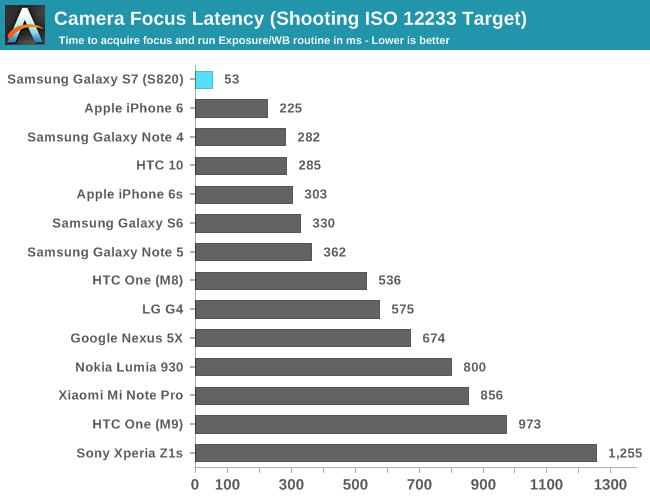
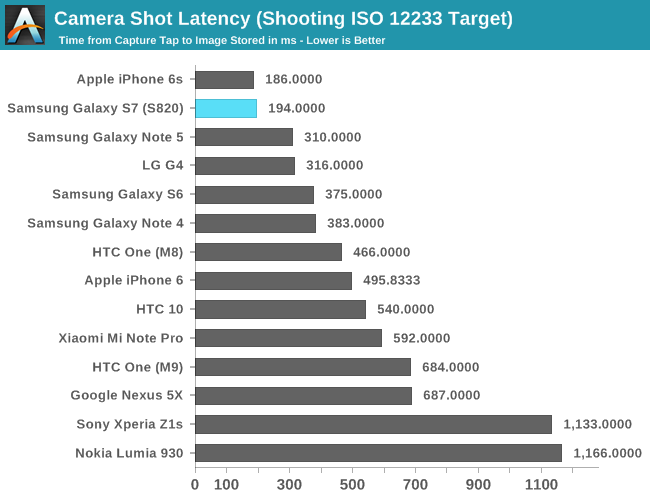
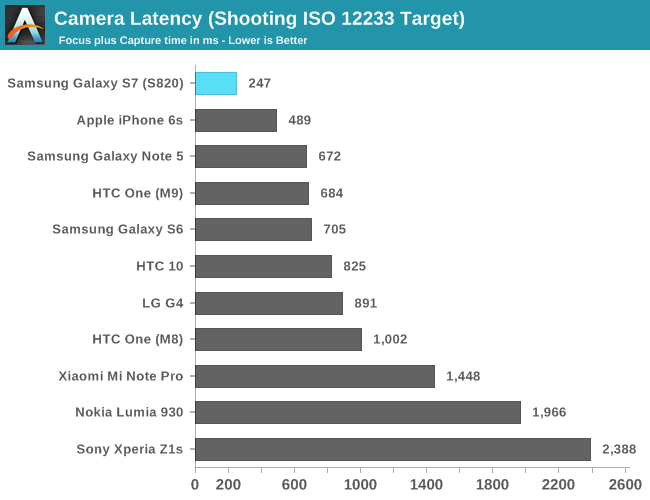
It’s probably not a surprise, but the Galaxy S7 is really, absurdly quick to take photos and focus. There is nothing out there that can realistically match the dual pixel AF system in the Galaxy S7, especially once you get into low light scenarios where traditional PDAF systems are overwhelmed by noise that can’t be easily canceled out. Samsung’s sheer prowess in semiconductor design and manufacture is really showing here, even in the best case.


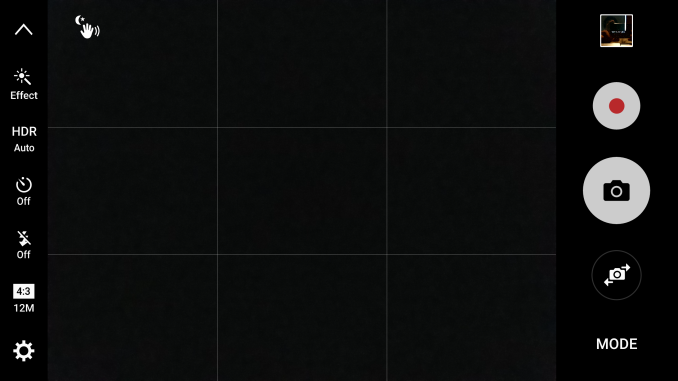
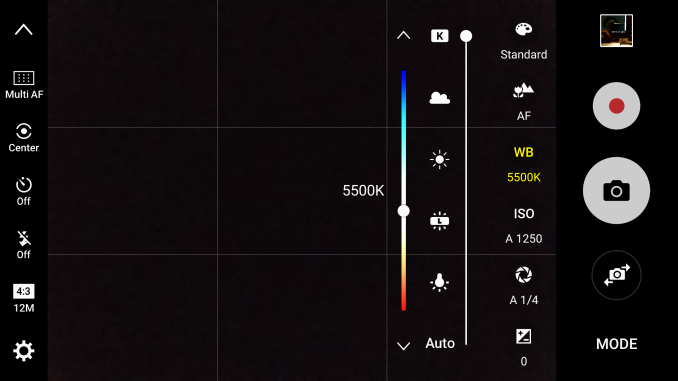
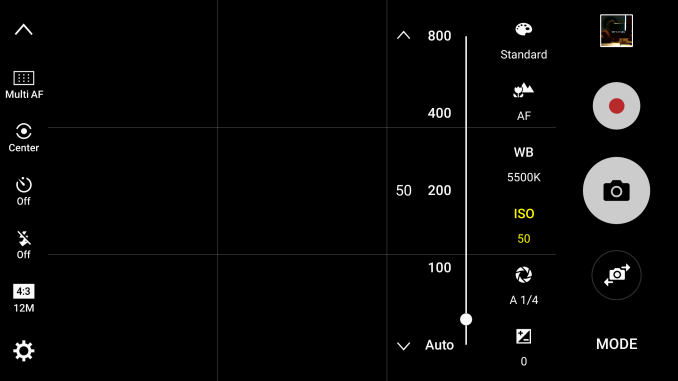








266 Comments
View All Comments
realbabilu - Thursday, July 7, 2016 - link
If we bought for performance. The lags or the speed of apps is quite small than last one or two years ago oneplus one s801, you can't fell it big difference unless on benchmarking apps.The photos can tell different story, you can know it good or bad than last year mobile or other features like ois
ntp - Thursday, July 7, 2016 - link
That's a very thoughtful reply, Impulses, thanks. But with the small sensors of smartphones I think 3/4ths of a stop is a significant advantage, more so than in the case of large sensor cameras, since we'd care about the F number in low light scenarios, where the ISO will be high. I'm just saying it should be better emphasized so people understand the real world advantages it gives.Impulses - Thursday, July 7, 2016 - link
It's a valid point, I'm just saying you can't look at that in a vacuum, specially since you're not looking at an ILC anyway... If you can't swap any parts, then the end result is all that really matters and that includes sensor efficiency, post processing (unless you're shooting RAW, a rarity on phone users), the presence of OIS, effectiveness of the latter, and even things like how smart the auto mode is...That last bit is probably beyond AT's more data driven evaluation, but a phone that relies to heavily on OIS for instance (or HDR) might take more blurry shots under real life conditions... That actually does favor a faster aperture but the point is emphasising specs in a vacuum is pointless.
mavsaurabh - Tuesday, July 12, 2016 - link
I just wish to reply regarding aperture , you rightly said that f no causes cost to skyrocket in case of lslr ens all else being equal, the catchphrase is all being equal ! In case of constraints of mobile photography, lens stack size & weight limitations, heat produced etc leads to various compromises like plastic lens which coupled with bigger apertures leads to higher corner aberration, diffraction etc etc. in end as Impulses wrote what matters is the end result which is fine tuned balance of various compromises made !I am a pixel peeper and street, landscape photgrapher by hobby with 25 years of film and digital shooting through Slr's , mobiles , compacts, Fuji X100.
My observation is that samsung uses hard sharpening and over saturated colors which "creates" pleasing photos on phone screen but if you display it on decent monitor and zoom to even 50% you will see various artefacts and no latitude for post processing. Now most of casual photographers will like larger than life portrayal or smearing of face pimples etc by clever use of face detection but hey any one who loves photography will differ!
I completely agree about fast focussing advantages but honestly i am yet to use a mobile camera with lens fast enough to freeze pet/ child movement in indoor light to take advantags of fast focussing.
Only phone which was able to do that with use of proper flash though is Nokia 808 Pureview and kudos to its mazing manual controls plus superb post processing which bettered apple even in natural post processing !
beggerking@yahoo.com - Wednesday, July 6, 2016 - link
please just stop those BS apple biased benchmarks at 10x lower resolution... just take them off the chart! its not even a good comparision and serves no uses.realbabilu - Thursday, July 7, 2016 - link
What you see on your screen mobile is what you get. Offscreen just measuring the gpu can do,basically it useless for user because you can't see it.lilmoe - Wednesday, July 6, 2016 - link
"The one notable shortfall here is that Samsung only allows 800 ISO max in manual ISO mode when the true maximum is 1250"I had that number in mind when I read it last night, and was too lazy to test. I've tested it now and my unit can go up to 1600 ISO. Is that also a variable difference in Samsung's sensor (mine is Samsung made), or is the extra third stop on mine extended?
Chris_m1296 - Wednesday, July 6, 2016 - link
Joshua ho, how did the exynos 8890 manage this score on slingshot es 3.1 unlimited? mine only got 2223 and even 3dmark themselves list the exynos version at 2223.UtilityMax - Wednesday, July 6, 2016 - link
Some people complain that the review is too harsh. But my personal view is that if this is a +650USD smartphone that _also_ happens to be carrier locked, it'd better be not just good, but _excellent_ in every respect. Otherwise, it's not clear what exactly justifies the price premium over a phone like Oneplus 3 or why a typical shopper should choose this over an apple product.Impulses - Thursday, July 7, 2016 - link
I kinda agree... I still feel some areas could've been better tested given how long the review date got dragged out, but there was still content here that's pretty unique to AT. I think the market, overall, is definitely giving the high end OEM too much of a pass given the prices phones are now commanding.A $1,000+ laptop with performance sapping bloat that the user can't remove (that aren't part of the core OS) would get ripped to shreds. It's time $700+ phones were held to the same standards.